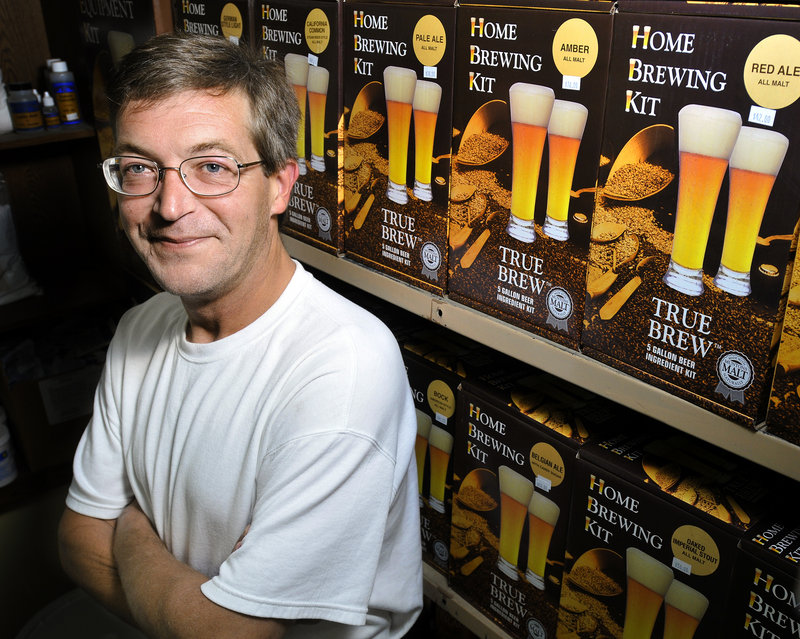Q: Is there a title for what you do?
A: Not really. People use the term home brewer, but I just see myself as a retailer or a hobbyist who turned this into a business in February of 1994.
Q: How did you get started in the craft of home brewing?
A: I started brewing as a sophomore in college. I was under the legal drinking age and it was a cheap way to make my own beer. A friend and I sent away for a mail-order kit. It was a very low-tech home brew system consisting of a few plastic pails and cooking on a stove top in a small apartment.
Q: Do you remember your first batch?
A: Knowing what I know today, it was probably horrible but, at the time, I thought it was fabulous. After college, I got into more high-tech or advanced brewing systems, starting batches from scratch, cracking my own barley with a cornmeal grinder and things like that.
Q: Did you take classes?
A: No. The process of home brewing has been around for hundreds of years and there is a lot of information out there. I learned by reading books and by trial and error. I also have a bachelor’s degree in biology, which is helpful in understanding the process and explaining the science, chemistry and physics of the fermentation process to my customers.
Q: What types of products does your shop sell?
A: For making beer, I sell equipment and ingredients like grains and malt extracts, kits and ingredients to set up individual recipes that a customer might want to make from scratch. For making wine, I sell yeast and chemicals and wine ingredient packages of different grape-juice varietal concentrates for people who want to make a cabernet or a chardonnay or merlot. I sell fruit purees and flavoring extracts for adding more flavor and 20 to 30 varieties of yeast, as those all impart subtle differences that help control the differences in a finished product.
Q: Why so many types of yeast?
A: Different yeasts impart different characteristics — some will give (the wine) a higher alcohol content, some will be fruitier or more estery (drier). Esters are the aromatic compounds that are the by-products of fermentation. I also sell similar ingredients for making mead, which is essentially a honey wine, though I don’t sell honey. And I sell books, testers, fermenters, corkers and transfer equipment.
Q: Do you also sell complete brewing systems?
A: Yes. Part of the brewing process is experimenting with different methods of making the beer or wine. Some prefer to keep it simple, using a pot on a stove top. Others want advanced systems that they make themselves, called brew sculptures. You can buy whole commercial systems that cost several thousand dollars or make your own for a few hundred dollars. I guide people through the process of gathering the parts to put those together, depending on how elaborate they want to be.
Q: How many bottles of beer or wine does the average recipe produce?
A: An average batch of beer is about 5 gallons, which translates to about two cases or 48 to 50 bottles of beer. The wine ingredient kits that I sell make 6 gallons or 30 standard bottles. I also sell the bottles here.
Q: Is it a difficult process?
A: No. If you can boil water, you can brew beer. It’s as simple as making tea. Only you are steeping grain and adding hops and bittering malts to adjust the flavor and aroma, and then adding yeast. The yeast eats the sugar in the malt extract and converts that into carbon dioxide and alcohol. The higher the sugar content, the higher the alcohol content. And making wine is even easier because there is no cooking involved at all.
Q: How long does the process take?
A: A kit can be ready to bottle in as little as one month because all of the work is done for you. If you make it from scratch, it can take six to eight months.
Q: Is it an expensive hobby?
A: That varies too. You can make 5 gallons of beer for $30 to $40 or 6 gallons of wine from about $70, depending on the grapes you use. But it doesn’t have to be grapes. You can make wine out of anything — elderberries, dandelion flowers. I have been making my own beer, wine and mead for many years now and have developed quite a few of my own recipes. I write down everything throughout the process to help trouble-shoot what may go wrong.
Q: What makes a perfect brew?
A: Beauty is in the eye of the “beer holder.” It’s something different for everyone. There are so many different varieties to choose from at the grocery store. There is as much art involved in crafting a fine wine or excellent beer as there is science.
Copy the Story LinkSend questions/comments to the editors.



Success. Please wait for the page to reload. If the page does not reload within 5 seconds, please refresh the page.
Enter your email and password to access comments.
Hi, to comment on stories you must . This profile is in addition to your subscription and website login.
Already have a commenting profile? .
Invalid username/password.
Please check your email to confirm and complete your registration.
Only subscribers are eligible to post comments. Please subscribe or login first for digital access. Here’s why.
Use the form below to reset your password. When you've submitted your account email, we will send an email with a reset code.